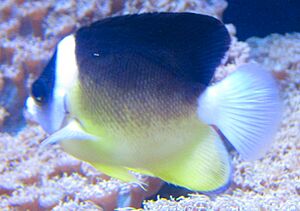Abe's angelfish facts for kids
Quick facts for kids Abe's angelfish |
|
|---|---|
 |
|
| Conservation status | |
| Scientific classification |
Centropyge abei (also known as Abe's angelfish) is a small, colorful fish that lives in the ocean. It is a type of marine angelfish and belongs to the family called Pomacanthidae. You can find this fish in the western Pacific Ocean.
Contents
What Does Abe's Angelfish Look Like?
Abe's angelfish has a tall, flat dorsal fin (the fin on its back). This fin is longer and less curved than those of most other small angelfish. It also has a small face with big eyes that are set quite far forward.
The body of Abe's angelfish is mostly yellow. The top part of its back, its dorsal fin, and the upper part of its head are black. It has a wide white stripe right in front of its dorsal fin. This stripe reaches down to the top edge of its gill cover. Its tail fin and the part of its body just before the tail (called the caudal peduncle) are white.
Younger Abe's angelfish might not have such clear markings. They might have a white stripe on their tail. This fish can grow up to about 9.1 centimeters (3.6 inches) long.
Where Does Abe's Angelfish Live?
Abe's angelfish lives in the western Pacific Ocean. You can find it in places like northern Sulawesi and Palau. It also lives off the coast of southern Japan and near Holmes Reef in the Coral Sea, which is off Queensland, Australia.
What is Its Home Like?
Abe's angelfish lives in water that is usually between 5 and 155 meters (about 16 to 508 feet) deep. It prefers areas with lots of rocks and rubble on the seafloor. The water temperature where it lives is usually around 20 to 21 degrees Celsius (68 to 70 degrees Fahrenheit). You can also find these fish on the outer slopes of coral reefs, in areas where the reef drops off steeply, and inside underwater caves.
How Was Abe's Angelfish Discovered?
Abe's angelfish was officially described as a new species in 2006. This was done by three scientists: Gerald Allen, Forrest Young, and Patrick L. Colin. The first fish of this type that scientists studied was found near Manado Tua, on Sulawesi.
The fish was named Centropyge abei to honor Yoshitaka Abe. He was the director of a public aquarium in Japan called Aquamarine Fukushima. His aquarium helped fund the trip where this new fish was found.


